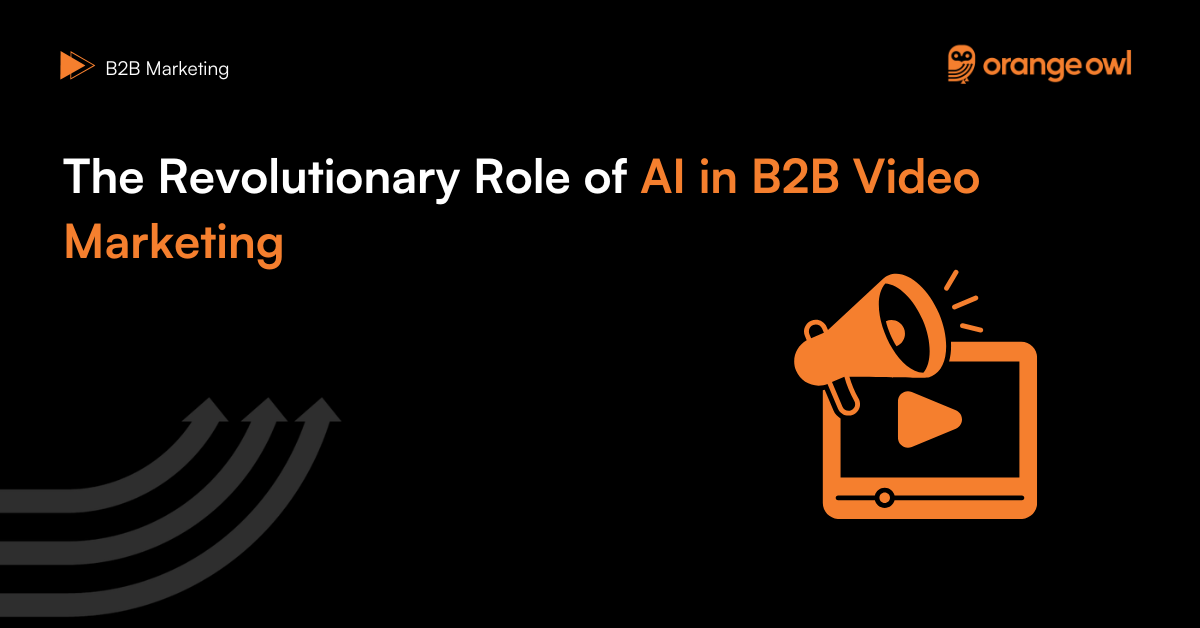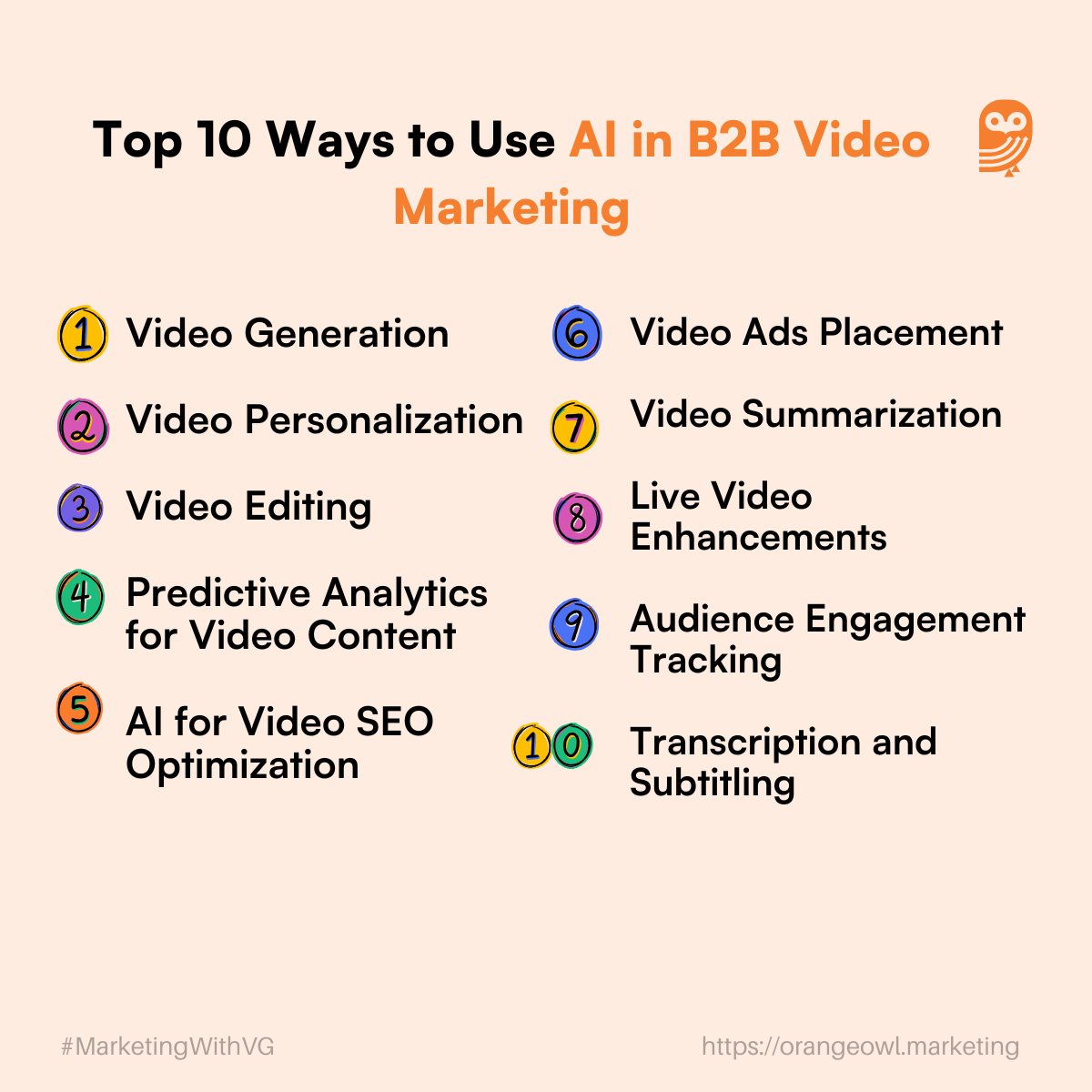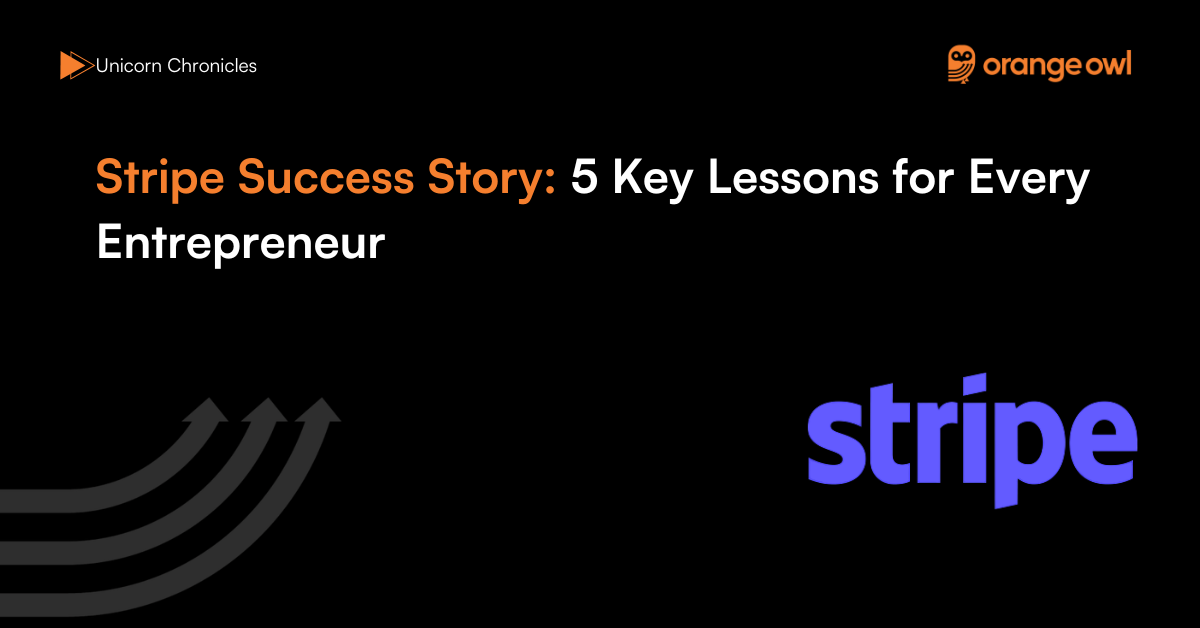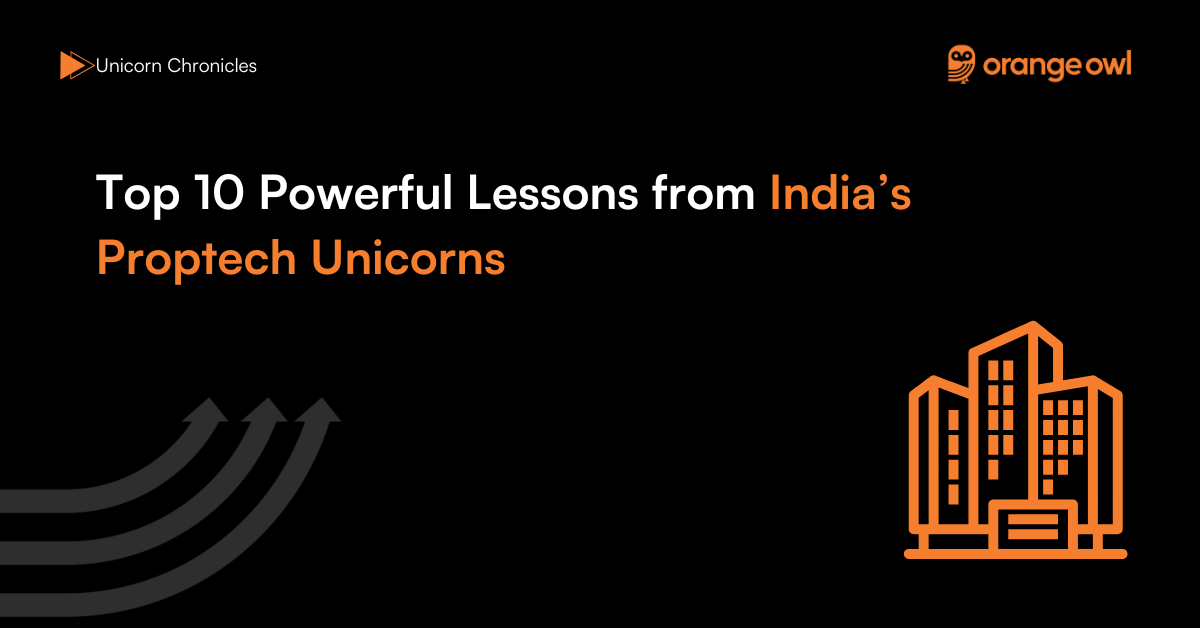The Revolutionary Role of AI in B2B Video Marketing
Vivek Goel
April 4, 2025

Table of Contents
Introduction
Artificial Intelligence (AI) in Video Marketing is revolutionizing how businesses create, distribute, and optimize video content. AI-powered tools enable marketers to automate video production, analyze audience engagement, and personalize content at scale.
This technological advancement allows brands to produce high-quality videos efficiently, tailor content to individual viewer preferences, and gain deeper insights into audience behavior. Consequently, AI in Video Marketing helps businesses craft more compelling video marketing strategies that resonate with their target audience, leading to enhanced engagement and improved conversion rates.
According to a recent report by Vidico, 90% of marketers affirm that video marketing delivers a strong return on investment (ROI), highlighting its effectiveness in driving business success. Additionally, 87% of marketers attribute an increase in lead generation to their use of video content. These statistics underscore the significant impact of AI-driven video marketing in boosting viewer engagement and driving conversions.
What is AI in Video Marketing?
AI in video marketing refers to the use of artificial intelligence technologies such as machine learning, computer vision, and natural language processing to create, edit, distribute, and analyze video content. These technologies enable marketers to streamline video production, automate editing processes, and enhance video quality with minimal human intervention.
AI can analyze large datasets in real time to understand viewer preferences, optimize video formats, and ensure content reaches the right audience at the right time.AI-powered tools assist marketers by generating automated video summaries, identifying key highlights, and even creating short-form content from long videos based on engagement patterns.
Additionally, AI can enhance video personalization by recommending content tailored to individual viewers, increasing watch time and audience retention. AI-driven video SEO tools further help businesses by optimizing video metadata, thumbnails, and transcripts to improve search rankings and discoverability.
By leveraging AI in video marketing, businesses can significantly enhance their video strategies, improve content relevance, and drive higher engagement. AI-powered analytics provide insights into viewer behavior, such as when they drop off or which parts of a video are most engaging, allowing marketers to refine future content for better performance. As AI continues to evolve, it is shaping the future of video marketing by making content creation more efficient, impactful, and tailored to audience needs.
Why is AI Important in Video Marketing?
1.Automated Video Creation
AI-powered tools generate high-quality video content by transforming text, images, and data insights into visually compelling videos. This allows businesses to create promotional content, product demonstrations, and social media videos with minimal human effort. AI-driven platforms use templates and automated voice overs to streamline video production. As a result, companies can produce professional-grade videos at scale without requiring extensive technical expertise.
2.Enhanced Personalization
AI analyzes viewer behavior, preferences, and past interactions to deliver highly personalized video recommendations. By tailoring content to individual users, AI ensures higher engagement and better audience retention. For example, AI can suggest product videos based on a user’s browsing history or viewing habits. This level of personalization improves customer satisfaction and increases the chances of conversions.
3.Optimized Video Editing
AI-powered video editing software automates key tasks like scene transitions, background enhancements, and subtitle generation. Features such as auto-trimming, color correction, and noise reduction improve video quality while reducing manual effort. Additionally, AI can automatically generate highlight reels or promotional clips from longer videos. This helps businesses create polished content quickly and efficiently.
4.Data-Driven Insights
AI tools provide real-time analytics on video performance, tracking key metrics like watch time, engagement rate, click-through rates, and audience demographics. By analyzing this data, marketers can identify which content resonates most with their audience and refine future campaigns accordingly. AI-powered insights help businesses make data-driven decisions to optimize their video marketing strategy for maximum impact.
5.Cost and Time Efficiency
AI significantly reduces the time and cost involved in video production by automating repetitive and labor-intensive tasks. Businesses no longer need large production teams or expensive editing software to create high-quality videos. AI-driven automation enables companies to scale their video marketing efforts efficiently while maintaining consistency in content quality. This makes video marketing more accessible for businesses of all sizes.
Top 10 Ways to Use AI in Video Marketing
Use Case 1: AI-Powered Video Generation
AI tools generate videos from text scripts, blog articles, or structured data, eliminating the need for manual video production. These tools use natural language processing and image recognition to create visually appealing content. Businesses can automate explainer videos, promotional clips, and educational content without professional editing skills. AI-driven video creation helps brands maintain a consistent content flow with minimal effort.
Hypothetical Example:
A travel agency leverages AI-powered video generation to create destination guides from blog posts. This automation boosts engagement by 40% as potential travelers interact more with immersive visual content.
Use Case 2: AI-Driven Video Personalization
AI customizes video content based on user preferences, behaviors, and demographics to create highly relevant experiences. AI can modify voice overs, subtitles, and product placements dynamically to match viewer interests. This ensures that audiences receive tailored video content, increasing retention and engagement. Personalized videos help brands build stronger connections with their target market.
Hypothetical Example:
An e-commerce brand integrates AI-driven personalization to recommend products via customized videos. By analyzing customer purchase history, AI curates personalized product showcases, boosting sales by 35%.
Use Case 3: AI-Based Automated Video Editing
AI automates video editing by removing unnecessary footage, adjusting lighting, and applying filters for professional-quality output. AI-powered tools analyze keyframes and audio to detect and highlight important moments. These tools save time and resources by streamlining video editing workflows for content creators. Automated editing ensures faster production cycles and improved video consistency.
Hypothetical Example:
A marketing agency utilizes AI editing tools to produce engaging social media ads quickly. This automation allows the agency to deliver high-quality videos within tight deadlines, improving campaign efficiency.
Use Case 4: Predictive Analytics for Video Content
AI predicts the type of video content that will perform best based on historical engagement data. Machine learning algorithms analyze past trends, audience behavior, and competitive insights to suggest content strategies. Businesses can use AI-driven predictions to develop high-performing video campaigns. AI ensures that resources are allocated effectively to maximize impact.
Hypothetical Example:
A streaming service deploys AI to predict trending video genres and recommends content to users. This strategy increases watch time and user retention, leading to higher subscriber satisfaction.
Use Case 5: AI for Video SEO Optimization
AI optimizes video metadata, including titles, descriptions, and tags, to enhance search visibility. AI tools analyze trending keywords and audience interests to improve video rankings on platforms like YouTube. AI-powered SEO ensures videos appear in relevant search results, increasing organic traffic. Businesses use AI to refine content strategy and enhance discoverability.
Hypothetical Example:
A YouTube content creator leverages AI to generate SEO-optimized video descriptions and tags. As a result, the channel experiences a significant boost in search rankings and audience engagement.

Use Case 6: AI-Powered Transcription and Subtitling
AI automates video transcriptions and generates subtitles in multiple languages, improving accessibility. AI speech recognition technology ensures accurate captions, making content more inclusive. Automated subtitles enhance user experience, particularly for hearing-impaired audiences or viewers watching without sound. AI-driven transcription also benefits video SEO by providing searchable text.
Hypothetical Example:
A multinational company uses AI-generated subtitles to localize training videos for global employees. This approach enhances understanding and engagement across diverse language-speaking teams.
Use Case 7: AI-Enhanced Audience Engagement Tracking
AI monitors viewer interactions, watch times, and drop-off rates to analyze audience engagement. AI-driven insights help businesses identify what works and what doesn’t in their video content. AI tools suggest modifications, such as content adjustments or pacing changes, to optimize future videos. Businesses can improve video effectiveness based on data-driven feedback.
Hypothetical Example:
A webinar platform employs AI to track engagement metrics and adjust content delivery in real time. This results in improved viewer retention and a more interactive webinar experience.
Use Case 8: AI for Smart Video Ads Placement
AI identifies the best moments within videos to insert advertisements for maximum impact. AI evaluates user behavior, viewing patterns, and contextual relevance to enhance ad placement strategies. This increases the chances of viewers watching and engaging with ads rather than skipping them. AI-powered ad targeting leads to higher conversion rates and ad revenue.
Hypothetical Example:
A digital advertising agency uses AI to optimize in-stream ad placements, reducing viewer drop-off. This strategic placement results in higher click-through rates and improved ad effectiveness.
Use Case 9: AI-Powered Video Summarization
AI extracts key moments from long-form videos to generate concise, engaging summaries. AI algorithms analyze speech, visuals, and engagement data to identify the most impactful highlights. These summaries are useful for creating promotional teasers, social media clips, and quick recaps. AI-driven summarization ensures audiences receive key takeaways without watching lengthy videos.
Hypothetical Example:
A news website uses AI to condense lengthy interviews into short highlight clips. This allows viewers to consume essential information quickly, leading to higher retention and shares.
Use Case 10: AI-Driven Live Video Enhancements
AI enhances live streaming experiences with real-time effects, automated translations, and sentiment analysis. AI-powered tools can add interactive elements like audience polls and automatic captions during live broadcasts. AI improves the quality of live videos by adjusting brightness, noise levels, and stream stability dynamically. Businesses use AI to create more engaging and professional live streaming events.
Hypothetical Example:
A virtual conference uses AI-driven live streaming enhancements to offer multilingual captions and audience sentiment analysis. This boosts participant engagement and ensures a smoother virtual event experience.
Common Myths vs. Facts About AI in Video Marketing
Myth: AI will replace human video creators.
Fact: AI assists in video creation by automating editing, scripting, and content generation, but it cannot replace human creativity. Storytelling, emotions, and brand voice still require human intervention to create compelling videos. AI works as a tool to enhance efficiency, not eliminate human involvement. Marketers can leverage AI to streamline video production while maintaining originality.
Myth: AI-generated videos lack originality.
Fact: AI does not create content in isolation—it enhances creativity by analyzing trends and audience preferences. AI provides data-driven insights that help marketers craft unique and engaging video content. Human input remains essential for creative storytelling, emotion-driven narratives, and brand-specific aesthetics. AI acts as a support system, not a replacement for originality.
Myth: AI tools are too expensive for small businesses.
Fact: Many AI-powered video marketing tools are designed to be cost-effective and scalable. Free or affordable AI video editing and creation platforms enable small businesses to produce high-quality content without large budgets. Cloud-based AI tools provide pay-as-you-go options, making them accessible to startups. Small businesses can leverage AI to compete with larger brands in video marketing.
Myth: AI-driven video marketing is only for large corporations.
Fact: AI video marketing tools are now available for businesses of all sizes, including startups and SMEs. AI-powered platforms offer budget-friendly automation, allowing smaller businesses to create professional videos without hiring large teams. From AI-generated subtitles to video analytics, businesses of any scale can benefit. The accessibility of AI helps level the playing field in digital marketing.
Myth: AI can’t analyze video performance accurately.
Fact: AI tools track engagement metrics like watch time, click-through rates, and audience retention with high accuracy. AI-driven analytics provide deep insights into what works and what doesn’t, allowing marketers to optimize video strategies. AI can even predict future engagement patterns based on past viewer behavior. Businesses can make data-driven decisions to improve video content effectiveness.
Emerging AI Trends Shaping Video Marketing
1.AI-Powered Hyper-Personalization
AI customizes video experiences by analyzing viewer behavior, interests, and past interactions. By leveraging machine learning, AI dynamically adjusts video content, such as personalized intros, recommended scenes, or tailored product placements.
This ensures that each viewer receives content that resonates with their preferences, increasing engagement. Brands can use AI-driven insights to segment audiences and deliver targeted messaging. As a result, businesses achieve higher retention rates and improved customer satisfaction.
2.AI-Driven Interactive Video Experiences
AI enhances video content by incorporating interactive elements such as clickable links, in-video quizzes, and dynamic call-to-actions. These features encourage viewers to engage more actively with the content, transforming passive watching into an immersive experience.
Interactive videos powered by AI can guide users through personalized journeys, such as product selection or learning modules. This technology is particularly useful for e-commerce, education, and brand storytelling. The result is deeper audience interaction, increased dwell time, and higher conversion rates.
3.AI-Enhanced Predictive Video Content Suggestions
AI predicts trending video topics and suggests content ideas based on real-time audience insights and online behavior. Machine learning algorithms analyze search trends, social media interactions, and user-generated content to forecast what will resonate with viewers.
This allows marketers to stay ahead by creating relevant and timely video campaigns. AI tools also provide recommendations for video formats, styles, and themes that will perform best. Businesses leveraging predictive analytics can optimize their content strategies for maximum reach and engagement.
Best AI Tools for Video Marketing
1.Synthesia – AI-Driven Video Creation with Realistic Avatars and Voiceovers
Synthesia enables businesses to create professional-quality videos without the need for actors, cameras, or studios. It uses AI-generated avatars that can speak in multiple languages and mimic human-like expressions.
This tool is ideal for corporate training, marketing videos, and explainer content. With its text-to-video functionality, companies can produce engaging videos quickly and efficiently.
2.Pictory – AI-Powered Automated Video Summarization and Editing
Pictory uses AI to transform long-form content, such as webinars, blog posts, and podcasts, into short, engaging video snippets. Its automatic summarization feature extracts key highlights and converts them into shareable videos.
The tool also offers AI-based editing, including background music, captions, and transitions. Businesses can use Pictory to repurpose content and enhance audience engagement effortlessly.
3.Vidnami – AI-Enhanced Script-to-Video Conversion
Vidnami allows marketers to turn written scripts into high-quality videos in minutes. AI automatically selects relevant visuals, stock footage, and background music based on the script’s context.
This eliminates the need for manual video editing, making content creation faster and more efficient. It is widely used for social media marketing, product promotions, and educational videos.
4.Magisto – AI-Based Smart Video Editing and Storytelling
Magisto leverages AI to analyze raw footage and create compelling video stories with minimal manual effort. It applies advanced editing techniques, such as scene detection, music synchronization, and facial recognition, to enhance video quality.
Businesses can use Magisto to create engaging promotional videos, social media ads, and brand storytelling content. The platform is designed for marketers who want professional-grade videos without complex editing skills.
5.Lumen5 – AI-Powered Video Creation from Blog Content
Lumen5 converts written blog posts into visually appealing videos using AI-powered automation. The platform extracts key points from text and pairs them with relevant images, animations, and background music.
It is especially useful for content marketers who want to repurpose written content into engaging video formats. Lumen5 helps brands increase their reach on social media platforms through compelling visual storytelling.
Conclusion
The Role of AI in Video Marketing is transforming the way businesses create, distribute, and optimize video content. AI-powered tools enable marketers to automate video production, personalize content, and analyze audience engagement in real-time.
By leveraging artificial intelligence, businesses can produce high-quality videos at scale, ensuring that content resonates with the target audience while maintaining efficiency and cost-effectiveness. This shift towards AI-driven video marketing is helping brands stay competitive in an increasingly visual and digital landscape.
With the ability to analyze viewer behavior and preferences, AI in Video Marketing enhances personalization, making video content more relevant and engaging. AI-powered recommendation engines, dynamic video customization, and automated editing tools allow businesses to deliver tailored experiences to different audience segments.
Additionally, AI-driven video SEO optimization improves discoverability, ensuring that videos reach the right viewers at the right time. These advancements are reshaping content strategies, making them more data-driven and impactful.
As AI technology continues to evolve, its influence on video marketing will expand, offering even more innovative solutions for content creation and audience engagement. From AI-generated video scripts to automated performance tracking, businesses can leverage AI to refine their marketing strategies and maximize return on investment.
The integration of AI in Video Marketing is not just a trend but a fundamental shift that will continue to shape the future of digital marketing, helping brands create compelling, data-driven, and high-performing video campaigns.
Frequently Asked Questions(FAQs) on AI in B2B Video Marketing
AI can analyze successful storytelling patterns and suggest structures that enhance viewer engagement. It can generate scripts based on data-driven insights, ensuring videos align with audience interests. AI-powered tools also help in adding compelling visuals and automated voiceovers to make stories more impactful. By refining narratives with AI assistance, businesses can create videos that emotionally connect with their target audience.
Yes, AI can automatically edit and optimize videos for different platforms such as LinkedIn, YouTube, and Twitter. AI tools adjust video length, aspect ratios, and subtitles based on platform requirements. They also generate short clips or highlight reels from longer videos, making content more versatile. This helps businesses maintain consistency across platforms while catering to different audience preferences.
AI automatically generates captions, subtitles, and translations in multiple languages, making videos more accessible. It also provides audio descriptions for visually impaired users, ensuring inclusivity. AI-powered speech recognition tools improve transcription accuracy, making content easier to consume. These enhancements expand the reach of B2B video marketing to a diverse and global audience.
AI-powered emotion recognition technology can analyze facial expressions, tone of voice, and speech patterns in videos. This helps businesses assess audience reactions and understand emotional engagement levels. AI tools can suggest improvements to make content more appealing based on emotional insights. By leveraging this data, marketers can create more impactful and emotionally resonant video campaigns.
AI automates A/B testing by analyzing multiple video variations and determining which one performs best. It tracks metrics such as watch time, engagement, and click-through rates to provide real-time insights. AI tools can quickly adjust elements like thumbnails, CTAs, and video lengths based on data. This ensures businesses optimize their video marketing efforts with minimal manual effort.
Yes, AI can generate personalized video content for email marketing based on recipient preferences and behaviors. It can customize greetings, product recommendations, or messages within the video to increase engagement. AI-driven analytics track how recipients interact with video emails and optimize future campaigns accordingly. This results in higher open rates, better conversions, and stronger customer relationships.
AI analyzes audience demographics, viewing habits, and engagement levels to deliver highly targeted video ads. It predicts which types of video content will appeal to specific customer segments. AI-powered platforms also optimize ad placements to maximize reach and minimize ad spend wastage. This results in better ROI and more effective B2B video marketing campaigns.
AI enhances live video streaming by offering real-time enhancements such as automatic captions, background noise reduction, and video quality adjustments. It can also provide real-time audience insights, helping hosts adapt content dynamically. AI-powered chatbots assist in live Q&A sessions, improving audience engagement. These features ensure smoother and more professional live streaming experiences for B2B audiences.
AI tools can scan video content for inappropriate language, brand guideline violations, or compliance risks before publication. It helps businesses ensure that all content aligns with legal and ethical standards. AI also monitors user-generated video content in real time to detect potential risks. This proactive approach helps B2B brands maintain a positive reputation and avoid regulatory issues.
AI will continue to evolve with advancements in deep learning, enabling hyper-personalized video experiences. AI-powered virtual presenters and deepfake technology may allow brands to create realistic video avatars for automated messaging. Interactive AI-driven videos will engage audiences through real-time customization and adaptive storytelling. As AI technology progresses, B2B marketers will have more sophisticated tools to enhance video strategies.


